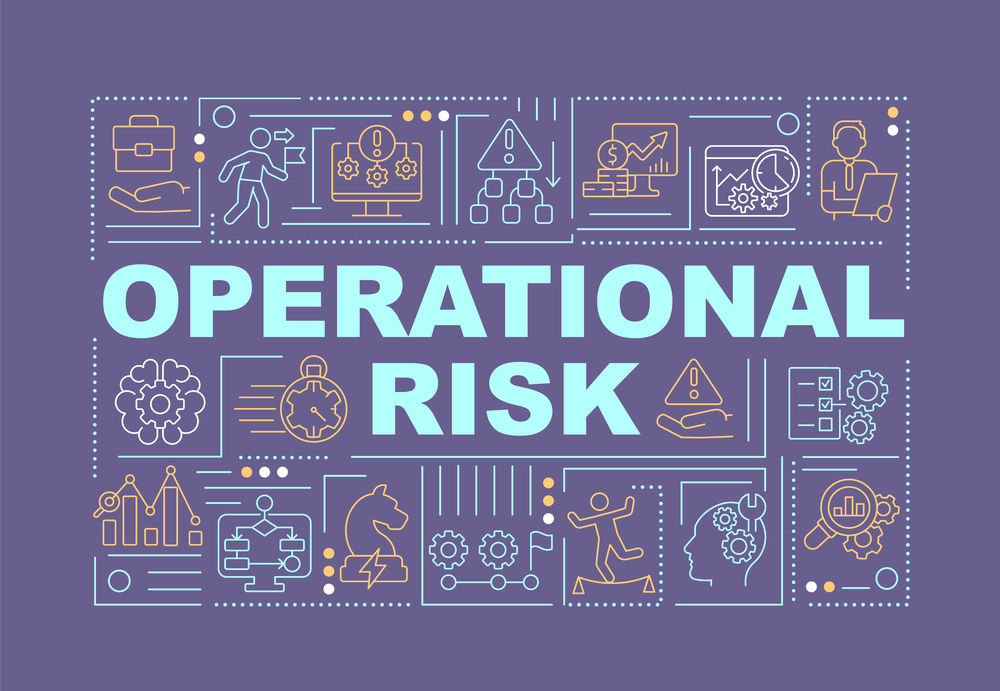Risk management is a critical aspect of the banking industry, and the (RCSA) process plays a vital role in identifying, assessing, and mitigating various risk types. A well-structured RCSA template can help banks effectively manage risks and comply with regulatory requirements.
In this blog post, we will explore the key components of an effective RCSA template for banks, discuss best practices tips for implementation, and highlight the importance of continuous improvement in risk management.
Risk Control Self-Assessment (RCSA) is a crucial component of effective operational risk management solutions, particularly within the banking industry.
This systematic, structured risk and control process allows organizations to proactively identify, assess, and manage risks, ensuring robust controls are in place to mitigate potential threats.

Robot Risk Assessment
Understanding Risk Control Self-Assessments (RCSA)
Purpose and objectives:
The primary objective of the RCSA process is to help banks identify, assess, and manage risks that may impact their operations, financial performance, and reputation.
Banks can gain valuable insights into their risk exposure and implement appropriate control measures to mitigate potential adverse effects by conducting a thorough self-assessment, which involves interaction with different departments and stakeholders.
Operational risks
Operational risk is classified into three different types. They can happen in any branch of a bank, such as a branch IT department, Sales department, Control & Marketing department, and any other departments.
All events have losses relating to them that are attributed to measurable damages. Controlling the frequency of occurrences may help minimize these losses, allowing the computation of the average frequency and the average loss value over a given period of time.
Benefits and importance in banking:
A robust RCSA process offers numerous benefits to banks, including improved risk awareness, enhanced regulatory compliance, and increased risk mapping operational efficiency.
Furthermore, RCSA helps banks make informed decisions and allocate resources effectively, improving business performance, growth and long-term sustainability.
- Improved risk awareness and understanding across the organization.
- Enhanced regulatory compliance and reduced exposure to fines and penalties.
- Increased operational efficiency by identifying and addressing potential vulnerabilities.
- Strengthened decision-making and resource allocation based on risk priorities.
- Greater stakeholder confidence in the organization’s risk management capabilities.
Key Components of an Effective RCSA Template
Risk identification and categorization:
The first and rcsa step in developing an RCSA template for risk managers is to identify and categorize the various risks faced by the bank. This may include credit, market, and operational risks, liquidity, and other relevant risks.
Banks can better understand their risk profile and prioritize risk management efforts by categorizing potential risks beforehand. A notable case study illustrates how a bank effectively identified and categorized risks using an RCSA template, leading to improved risk management practices.
Risk assessment and prioritization:
Once the risks have been identified and categorized, the next step is to further assess risks and determine their likelihood and potential impact. This involves assigning a risk rating based on probability, severity, and velocity.
Prioritize the residual risks and risk and derive risk management practices to mitigate the high risks. This ensures banks can focus their attention and capital resources on the most significant threats to their operations and performance.
Risk mitigation and control measures:
The RCSA template should outline the specific control measures that will be implemented to mitigate the identified risks. This may include policies, procedures, systems, or other actions that help reduce the likelihood or impact of adverse events.
Additionally, the template should specify the individuals or teams responsible for implementing and monitoring these controls.
Monitoring and reporting:
An effective RCSA template should include a system for monitoring and reporting on the performance results of risk assessments and controls.
This may involve regular reviews, audits, or other assessment methods to ensure that the controls function as intended and that any issues are promptly addressed.
Regular reporting to senior management and other stakeholders is also essential for maintaining transparency and accountability
Risk Control Self Assessment (RCSA) – An Overview
Risk Control Self-Assessment is a proactive risk management tool that enables organizations to systematically identify, assess, and mitigate risks related to their operations, finances, and reputation. The RCSA process encourages a risk-aware culture within the organization, empowering employees at all levels to take responsibility for total risk indicators operational risk management, and control.
RCSA Workflow
The RCSA workflow consists of several interconnected business processes, which we will outline below:
Step 1 – Document Control Environment:
Organizations should establish a comprehensive control environment that provides a solid foundation for effective
This includes defining risk governance structures and risk appetite, setting risk appetite, doing risk assessments and developing policies and procedures to guide risk identification, assessment, and mitigation efforts.
Step 2 – Identification of Risks:
In this first step, organizations identify risks and document the risks that may impact their operations business strategy, finances, or reputation. This may involve identifying risks from the various departments, cross-functional teams, and external stakeholders.
Risks should be assessed against key business objectives, and appropriate controls should be identified for each risk.
Step 3 – Assessment of Risks and Controls:
During this stage, organizations should also assess risks and each identified risk’s likelihood and potential impact, assigning a risk rating based on probability, severity, and velocity.
This prioritization enables organizations to focus on the most significant risks and allocate resources accordingly. In addition, the effectiveness of existing controls should be reviewed and evaluated to ensure they are adequate in mitigating risks
Step 4 – Control Identification and Evaluation:
Organizations must identify and evaluate additional controls to address these vulnerabilities if existing controls are deemed insufficient or new risks emerge.
This may involve implementing new policies, procedures key controls, or systems to reduce the likelihood or impact of adverse events. Controls should be regularly monitored and adjusted as needed to maintain their effectiveness.
Step 5 – Corrective Actions:
When control gaps or deficiencies are inherent and residual risks are identified, organizations must develop and take action plans to implement corrective actions to address these issues.
This may involve updating policies, procedures, or systems, providing additional training or resources, or improving risk management capabilities.
Corrective actions should be tracked and monitored to effectively address the identified issues.

What Is Rcsa
Best Practices for Implementing RCSA in Banks
Stakeholder engagement and communication:
Effective communication and engagement
Training and awareness:
Ensuring all employees understand the RCSA process and their roles in risk management is crucial for successful implementation.
Regular training sessions, workshops, and awareness programs can help instil a risk-conscious culture within the bank and empower employees to contribute to and enhance the organization’s risk management efforts.
Regular reviews and updates:
The the risk and control landscape in the banking industry is constantly evolving, making it essential to review and update the RCSA & templates periodically. Banks should regularly assess their risk exposure and control measures, making adjustments as needed to adapt to changing conditions, regulatory requirements, or industry trends.
The Role of Technology in RCSA
Automation and efficiency:
Technology can significantly improve the efficiency & ppt of the RCSA process by automating manual tasks, streamlining workflows, and reducing human error.
Banks can leverage software solutions and data analytics tools to collect, analyze, and report risk-related data, allowing them to make more informed business decisions and focus their resources on high-priority risks.
Data analysis and visualization:
Advanced data analytics and visualization tools can provide banks with valuable insights into their risk exposure, helping them identify patterns, trends, and areas of concern. These tools can also facilitate communication and collaboration among stakeholders by presenting complex data in a clear, digestible presentation format.
Integration with other risk management systems:
Integrating the RCSA process with other risk management systems, such as enterprise risk management (ERM) or governance, risk optimization, and compliance (GRC) platforms, can provide a more holistic view of the bank’s risk profile.
This integration enables banks to align risk management efforts and ensure consistency across risk categories and business units.
Continuous Improvement in Risk Management
Lessons learned and feedback loops:
Continuous improvement is a critical aspect of effective risk management. Banks should establish feedback loops to learn from past experiences and identify areas for improvement. By analyzing the outcomes of previous RCSA cycles, banks can refine their processes, enhance their control measures, and strengthen their overall risk management capabilities.
Adapting to regulatory changes and industry trends:
The banking industry is subject to frequent regulatory changes and shifting market dynamics. Banks must remain agile and adaptable, adjusting their RCSA processes to stay compliant and maintain a competitive edge. This may involve updating risk categories, control measures, or reporting mechanisms to align with new regulations or industry best practices.
Benchmarking and performance measurement:
To gauge and evaluate the effectiveness of their RCSA process, banks should establish performance metrics and benchmarks. This information can help identify areas where the bank is performing well and where improvements are needed.
By monitoring their performance over time and comparing it to industry peers, banks can ensure that they maintain a high standard of risk management and continually strive for excellence.
RCSA Enterprise Report
An RCSA Enterprise Report is a comprehensive, high-level summary study of an organization’s risk profile, control environment, and risk management activities. This report provides senior management, regulators, and other stakeholders with a clear and free risk assessment template
overview of the organization’s risk management performance and areas for improvement. The RCSA Enterprise Report typically includes:
- A summary of key risks and their categorization.
- An assessment of risk likelihood, impact, and prioritization.
- A description of the control environment and effectiveness of existing controls.
- Identification of control gaps or deficiencies and corresponding corrective actions.
- Insights into trends, patterns, and emerging risks.
- Performance metrics and benchmarks to measure the effectiveness of the RCSA process.
The RCSA template is a powerful tool for banks to manage risks effectively and maintain regulatory compliance. By incorporating key components, such as risk identification, assessment, and mitigation measures, and adhering to best practices,

RCSA Operational Risk
banks can create a comprehensive RCSA process that promotes a risk-conscious culture and ensures the organization’s long-term success.
Leveraging technology and fostering a mindset practice of continuous improvement can further enhance the effectiveness of the RCSA process, allowing banks to adapt and thrive in an ever-changing financial risk landscape.
Risk Control Self-Assessment is a vital component of effective operational risk management, particularly within the banking sector.
By implementing a proactive approach robust RCSA process, organizations can proactively identify, assess, and mitigate risks, ensuring their operations’ long-term success and stability.
This comprehensive guide provides a step-by-step overview of the RCSA workflow, highlights the benefits of RCSA, and underscores the importance of automation in enhancing risk management capabilities.
By mastering the RCSA process, organizations can foster a risk-aware culture, have risk managers make informed decisions, and maintain regulatory compliance, ultimately bolstering stakeholder confidence and achieving their business objectives.

Chris Ekai is a Risk Management expert with over 10 years of experience in the field. He has a Master’s(MSc) degree in Risk Management from University of Portsmouth and is a CPA and Finance professional. He currently works as a Content Manager at Risk Publishing, writing about Enterprise Risk Management, Business Continuity Management and Project Management.

